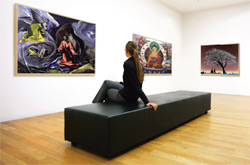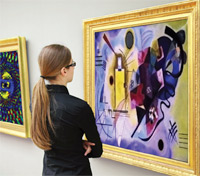In 2007, before the bubble burst in the world financial markets, British artist Damien Hirst created a work of art valued at $100 million. It was a human skull, cast in platinum and studded with diamonds. The piece was the talk of the art world—not for its stunning aesthetic but for its drop-dead price tag. Hirst’s art makes fun of the greed and materialist excess that ultimately led to the stock market careening out of control while simultaneously being an example of it. The entire event—an intentionally vulgar object sold for a ridiculous sum—epitomizes the postmodern art establishment, which has for decades celebrated the archly ironic, the crassly superficial, or the simply shocking. To a great extent over the last thirty years, the art world’s cognoscenti—critics, artists, dealers, and museum curators—have created a climate in which art has no purpose, meaning, or higher aesthetic value, having dismissed the pursuit of those qualities as hopelessly naïve.

But is it? In the past year, a number of prominent art exhibitions at significant museums in Europe and the United States have started to open up the relationship between art and questions of meaning and human purpose. It is too early to tell whether these exhibits actually express something new and deeper bubbling up within the art establishment. They may in fact simply represent a calculated response to the growing spiritual interests of the “cultural creatives,” who are certainly a demographic among art consumers. Taken on their own merits, however, these exhibitions demonstrate that the question of meaning and the pursuit of the transcendent are now and have always been enduring motivations for creating art.
“Traces of the Sacred,” held at the trend-setting Pompidou Centre in Paris, was the largest and most prestigious of these exhibits. The entire show was organized around fundamental existential and spiritual questions: “Where do we come from? What are we? Where are we going?” An impressive three hundred and fifty works of art were on display by nearly two hundred artists, who ranged from the early pioneers of abstraction from the beginning of the twentieth century to radical provocateurs of more recent times. Through the remarkable diversity of media on display—painting, drawing, sculpture, photography, video, installation, and more—the exhibit demonstrated how the search for transcendence is being channeled in new and creative ways. The sacred—“with or without God, with or without religion”—as the exhibit made very clear, has been “a crucial inspiration to many artists.”
Many of the works in the Pompidou’s exhibit were among the most important in twentieth-century art history, but they were placed in a new context. Take, for example, those by the famous Russian painter Wassily Kandinsky. Kandinsky is one of the first artists credited with breaking the tradition of representational art—paintings that represent or depict objects in the real world—and creating the first purely abstract painting. In the last fifty or so years, as the art world became increasingly fascinated with the superficial, his work has been admired almost exclusively for the interplay of color and form—elements that relate to the surface of the canvas rather than to any meaning or depth intended by the artist. But in this exhibit, with its focus on the sacred dimension of art, Kandinsky’s painting could be seen for the spiritual breakthrough that it was meant to be. His experiments with bright colors on canvas were striving to reveal something more essential and deep than could be expressed through representational painting of objects. In 1911, as his first abstract paintings hit the art scene, Kandinsky published his first book, Concerning the Spiritual in Art. He wrote, “Color is the keyboard, the eyes are the hammers, the soul is the piano with its many chords. The artist is the hand that, by touching this or that key, sets the soul vibrating automatically.” At the Pompidou Centre, Kandinsky’s vibrant and colorful shapes could once again be valued for their power to convey the pulse of life that vibrates within the soul.

Elsewhere in Europe, other exhibits addressed the religious content of current art from a new perspective. The Stedelijk Museum in Amsterdam explored the spiritual and religious underpinnings of modern art. As one Dutch artist pointed out, “religion and art were born at the same time,” referring both to how intertwined the two are historically and to how religion and art spring from the same source in humanity that seeks the good, the true, and the beautiful. The exhibition, entitled “Holy Inspiration: Religion and Spirituality in Modern Art,” was set up in a Gothic church, which created the perfect environment to draw attention to the sacred dimension in the modern and contemporary art on display. And Amsterdam wasn’t the only Dutch city to seek out the sacred in art. The city of Utrecht had a three-part initiative that focused on “The Return of Religion and Other Myths.” Similar themes also were explored by museums in Germany. The Center for Art and Media (ZKM) in Karlsruhe looked at the power of video and television to communicate religious material, while a smaller version of the Pompidou Centre’s “Traces of the Sacred” exhibit traveled to Munich.
In the United States, too, there have been signs that, as The New Yorker art critic Peter Schjeldahl put it, a “sea change” may be underway. Writing about an exhibit entitled “After Nature” at the New Museum in New York City, Schjeldahl perceptively observed that the art displayed “a shift of emphasis, from surface to depth.” Artists, he went on, were “shrugging off the allures of the money-hypnotized market” and engaging with questions about humanity’s future. “After Nature” included ninety works by an international group of artists, filmmakers, and writers who were all exploring what Earth would be like in the wake of environmental collapse and an implosion of human civilization. Combining apocalyptic scenarios and mystical visions, the unsettling intensity of the exhibit had a powerful effect—a cry for a change of course so that such tragedies will not come to pass. Not only was the frenzied pursuit of fame and fortune losing its grip on artists and the art world, as Schjeldahl was suggesting, but here art was being used for the purpose of sounding the alarm and catalyzing change. A similar tone pervaded Pittsburgh’s 55th Carnegie International exhibition, a survey of contemporary art that was themed “Life on Mars.” Forty artists were chosen for work that grappled with the question of what it means to be human and “with the more infinite sense of being part of the larger universe and finding ourselves on the inside and looking out.” While neither of these exhibits explored overtly religious or spiritual themes, the engagement with life’s biggest questions marks a significant shift from the glitz, irreverence, and superficiality so prevalent in the postmodern art world.
Whether or not these recent exhibitions are signs of a more widespread phenomenon, they do indicate that cracks are beginning to appear on the glossy facade of postmodern art, revealing the longing for depth that is so much a part of the human experience. In the early twentieth century, as the world fell into the abyss of the First World War, Kandinsky apparently said, “The more frightening the world becomes . . . the more art becomes abstract.” At the time, Kandinsky was searching for something beneath the surface, beyond the world of form seen by the eye and into a realm of experience felt in the human soul. Perhaps now, in the face of even more significant dangers and after decades of soul-denying art, artists and museums are realizing that art must once again assume a role of bringing human beings in touch with something deeper, primary, and urgent. The art establishment has long been an arbiter of culture—dictating what is in and what is not—in ways that go far beyond the multimillion-dollar world of collectors and into the arenas of aesthetics, literature, and film. Were this establishment to now inquire into and explore the deeper currents and drives within humanity, it might help catalyze a shift that could ultimately lead to a new phase in culture.







